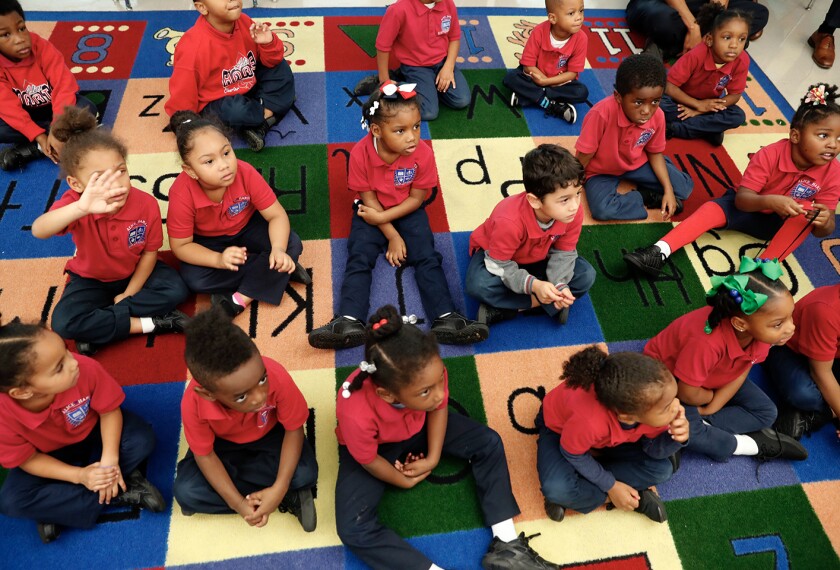The latest analysis of a long-running early-childhood-education program for children of low-income families in Chicago suggests economic payoffs from such services that continue well into adulthood.
Researchers looking at data from the study, which is now more than 20 years old, say that for every dollar spent on children who attended the Chicago Child Parent Centers, almost $10 is returned by age 25 in either benefits to society—such as savings on remediation in school and on the criminal-justice system—or to the participant, in the form of higher earnings.
“The study is significant, given it is the only one of a sustained public school program and one of the very few which go into adulthood,” Arthur J. Reynolds, a child-development professor at the University of Minnesota-Twin Cities and the lead researcher on the project, said in an e-mail.
He added that the benefits are probably underestimated because he has found some unexpected outcomes, such as participants’ being more likely than those in the comparison group to hold private health insurance and less likely to have mental-health problems. (“Chicago Data Bolster Case for Early-Childhood Programs,” August 15, 2007.)
But some experts caution that the children served by the Chicago program and similar efforts were very disadvantaged, and that providing such services to middle-class families in universal preschool programs are unlikely to result in the same return on investment.
“The biggest argument against the Chicago economic data is that it is still largely a ‘boutique’ program that cost more and provided more services than most current universal and preschool programs,” said Lisa Snell, the director of education and child welfare at the Los Angeles-based Reason Foundation, a free-market-oriented think tank. “It is hard to imagine that current programs will have the same kinds of economic payoffs as the Chicago program.”
The conclusions were presented late last month at a meeting in San Francisco of the Society for Prevention Research, based in Fairfax, Va.
Parent Involvement
For background, previous stories, and Web links, read Prekindergarten.
The Chicago Longitudinal Study originally included 1,539 children from low-income African-American and Hispanic families who began in the early-education program run by the Chicago school system at 25 sites in either 1985 or 1986.
The Chicago program began in 1967 at sites in or near elementary schools. Similar to the federal Head Start program, the Child-Parent Centers provide comprehensive education, health, and family-support services to children ages 3 to 9.
Unlike in Head Start, all the teachers in the program have bachelor’s degrees and are paid at the same level as K-12 teachers.
In addition, parents are expected to participate in the classroom—a component that distinguishes the Chicago program from other early-intervention initiatives—and the children in the study received home visits from a “school-community representative.”
“The parents were expected to get involved, and there were 30 different ways [for parents to participate], so nobody said no,” Mr. Reynolds said.
While the study was not designed as a true randomized trial, a comparison group including children who were matched to the participants on socioeconomic factors and demographic variables, wsuch as family size and parents’ employment status, has been used to track the effectiveness of the intervention. Children in the comparison group took part in other early-childhood programs, such as Head Start, or full-day kindergarten.
Last year, Mr. Reynolds released findings in the Archives of Pediatrics and Adolescent Medicine, a monthly journal, based on study of participants at age 24. Those findings showed that the adults had acquired more education and were less likely to commit crimes than those who had not received the same level of service.
A Body of Evidence
Because of its evidence of lasting positive effects, such as lower special education costs and less welfare dependency, Mr. Reynolds’ study on the Chicago program is often used as one of three long-running research projects to argue for public spending on early-childhood education. The other two are the High/Scope Perry Preschool study, which ran in Ypsilanti, Mich., outside Detroit from 1962 to 1967, and the Carolina Abecedarian Project, in Chapel Hill, N.C., which provided services from birth through age 5 to 112 children from low-income families born between 1972 and 1977.
The Chicago study stands out, however, because it is not a demonstration program as are the others. It has been operated by a public school system and thus is likely more “generalizable to other similar and contemporary locations and contexts,” Albert Wat, a state-policy analyst at the Washington-based advocacy group Pre-K Now, wrote last year in the report “Dollars and Sense: A Review of Economic Analyses of Pre-K.”
The Chicago program “demonstrates that public schools can effectively implement high-quality pre-K programs that produce long-term positive gains,” he wrote.
Still, Mr. Reynolds concludes that the newest “evidence strengthens the findings of a high return on investment of public programs, if they follow the key principles of effectiveness.”
Mr. Reynolds’ new analysis, which will be released in a research paper later this year, also provides a comparison of the economic benefits of various types of preschool programs.
It uses an average of all the cost-benefit studies that have been conducted on other popular policies, such as full-day kindergarten, class-size reduction, and the federal Women, Infants, and Children, or wic, nutrition program.
The comparison shows that preschool programs have by far the highest return, $6.02 for every $1 spent, compared with $2.47 for small classes, $3.07 for wic, and nothing for full-day kindergarten.



